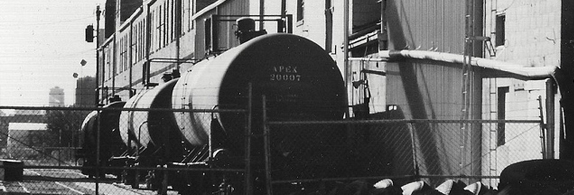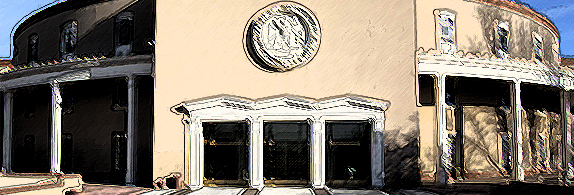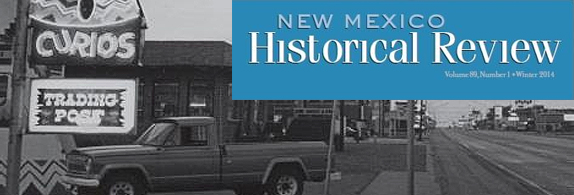Mountain View Gets the Shaft Again

The Mountain View Neighborhood area in Albuquerque’s South Valley has long been recognized as the city’s most pollution-burdened stretch of land. And at the end of last year it had another source of pollution dumped into its midst by Governor Martinez and her Economic Development Secretary John Barela, without so much as a by-your-leave. They presided over groundbreaking ceremonies for something called rail-to-truck “transloading” center on 36 acres on what’s been called “industrial land” near South Broadway just west of I-25.
No one in the neighborhood was consulted.
Mountain View Neighborhood goes roughly from the Rio Grande east to I-25 and north from the Isleta Curve to Woodward Avenue SW. Its population is overwhelmingly Hispanic.
Mountain View already has two Superfund Sites. One of them at the now demolished GE Jet Engine Plant on Woodward between Second Street and South Broadway was the object of the largest Environmental Law Suit ever brought by the state of New Mexico against corporate entities. Attorney General Patricia Madrid brought the $4 billion suit in 1999. New Mexico lost the case five years later.
Mountain View has huge petroleum storage tanks that leak periodically. The GE plant polluted its groundwater and is still cleaning it up after decades. Many of Bernalillo County’s major “brownfield” sites, 31 industries the EPA designates as contributing to air and water pollution, and numerous hazardous waste facilities including the Albuquerque metro area’s only sewer treatment facility are there. More than 20 junk yards selling auto parts are scattered throughout the area. And Mountain View has at least five concrete manufacturing companies. The well at the Mountain View Elementary School was closed in the l980s because of contaminants in the water, the source of which, some speculated, came from Sandia and Kirtland Air Force base and their long practice of dumping chemicals into Tijeras Arroyo which runs right past the school. And that’s just a short list.
The $7.7 million transloading facility will see a heavy increase of 18-wheeler traffic in the area, with no new street infrastructure that one can see, but the inevitability of increased noise and air pollution on existing streets. The volume of traffic could be tremendous, as the next transloading facility is some 200 miles south in Santa Teresa. Multiple railroad tracks would run through the area and what the rest of the congestion might be, no one knows for sure. The contents being loaded and unloaded, and even stored at the area, could be petrochemicals of various kinds and other industrial liquids like solvents. No one knows for sure what those trains and trucks will contain. It could be anything. And no one in Mountain View was informed about any of the possibilities. Apparently state government trumped county government and just gave the OK with no environmental impact analysis whatsoever of the project. So while the state touts a projected 200 new jobs, there’s no data on the impact of massive freight movement on the quality of life in Mountain View. Just because parts of it are zoned for heavy industry is no reason to deny some 3,000 to 4,000 area residents any voice in the matter at all.
Why wasn’t there an impact statement? Marla Painter, an environmental and social justice activist and Mountain View resident, pointed out that unlike the federal government and its various agencies, including the EPA and BLM, the State of New Mexico has no requirement for environmental impact statements on big projects within its jurisdiction. Long time State Representative Gail Chasey introduced a bill in the State House in 2013 to create what she called a “Consolidated Environmental Review Act.” Its purpose would be, according to the bill, to “take all action necessary to provide the residents of New Mexico with clean air and water; enjoyment of aesthetic, natural, scenic and historic environmental qualities; healthy fish and wildlife populations; and freedom from threats to human health and excessive noise and light pollution.” It seems unlikely that such a deeply needed bill would ever be signed into law by Governor Martinez.
Painter has commented that the process of imposing the train and trucking center “is the most terrible of any past industrial projects,” referring to development by gubernatorial fiat.
“How can this happen with no general public knowledge?” she asked. One reason, Painter said, is that Mountain View has “never been afforded a Sector plan that would include conditions on future development there. We as a community produced a plan and were in mediation with the business community to include their concerns. However, our County Commissioner Art De La Cruz, withdrew the plan the day it was to be voted on by the County Planning Commission.”
The environmental burdens on the residents of Mountain View are already vastly more onerous than those suffered in any other part of town. They’ve taken it in the neck year after year. And the new truck and train facility with its tremendous traffic only adds pressure, pollution, and congestion to an already nearly impossible situation. The project appears to be a done deal, but it could still be evolving. I’ve been told that communication between Mountain View residents and the project developer, GandyDancer LLC, is under way. We’ll keep track of the situation as best we can.
The Legislature is Not a Big Sucking Void

If you’re an idle observer of the New Mexico State Legislature you might think not much is going on up there these days. Legislators, like members of Congress, have a collectively low popularity rating, and many folks think nothing goes on in the Round House but boozing and lobbying and avalanches of arrogant, self-important titter. It’s a misconception, of course, but how could it come to be?
Especially now, when there’s a burgeoning of excellent legislative coverage—with Margaret Wright, Mathew Reichbach and Andrew Lyman producing New Mexico Political Report, Joe Monahan doing his marathon digging, the ABQ Free Press, New Mexico In Depth, Steve Terrell at the Santa Fe New Mexican, the Weekly Alibi’s evolving perspective, Peter St. Cyr at the Santa Fe Reporter’s Morning Word, not to mention the staff reporting in the back pages of the Journal, the sporadic, but improving, mainstream TV coverage, strong reporting from KUNM, and KNME’s weekly interview and local opinion show.
And yet if you have a specific interest—New Mexico’s environment or child care issues or education or literally a myriad of others—the best way to get a full picture of the frantic pace and activity in the Round House is to get your news from issue oriented NGOs.
For environmentalists there are numerous organizations that watchdog the legislature—the Sierra Club, Amigos Bravos, the New Mexico Wilderness Alliance as well as Environment New Mexico, Food and Water Watch, Environmental Law Center and many more.
One of my favorite sources of such information is Conservation Voters New Mexico (CVNM) which is keeping tabs on some 90 environmental and related bills being floated this year in the New Mexico House and Senate. They just sent their membership an exhaustive list of the proposed legislation they are monitoring. If you want to get a real feel for the frantic pace of legislative activity that flows from 70 state representatives and 42 state senators, CVNM gives you a full emersion experience.
Here’s a small number of excellent legislative ideas drawn from a big pile that deserve environmental support:
Taos legislator, Democrat Roberto “Bobby” J. Gonzales proposed House Bill (HB) 58 which would increase the gas tax to create a major road improvement fund. CVNM says that “Gas taxes are one way of ensuring that the costs of vehicle-miles-traveled—such as air pollution, impacts of extraction and refining industries and climate change—are offset” to some degree.
Gonzales also sponsored HB 111, which would allow small towns and counties to create community-wide alternative energy projects in which customers help to sustain something on the order of alternative energy co-ops.
HB 114, sponsored by Santa Fe Democrat Brian Egolf would forbid companies to lie or falsify information given to the NM Environment Department NMED in order to get permits or pass other regulatory requirements. Now there’s a good idea if there ever was one. But how odd that lying is apparently such a normal practice of businesses dealing with NMED that Egolf would have to propose legislation to put an end to it.
HB331, sponsored by Democrat G. Andres Romero from the south valley in Bernalillo County, would do away with a dangerous practice of appointing members of the Albuquerque Bernalillo Country Water Utility Authority (ABCWUA) from existing political entities and requiring they be elected outright. Boards that are made up of members elected to other entities have members that are unaccountable to any direct electorate. The County Commissioners and City Councilors who sit on the ABCWUA board are accountable only to those who elected them from their respective districts. They were not elected to serve on the ABCWUA board and are therefore, in that position, functionally accountable to no one. When have you ever heard of a commissioner or a councilor being challenged in an election for actions they’ve taken on an appointed board?
On the Senate side, SB94, sponsored by Albuquerque Democrat Cisco McSorley, would allow farmers to be licensed to grow hemp, a particularly drought resistant, insect repelling, highly versatile plant that can be turned into everything from milk and paper, to plastics and clothing. It would be a windfall cash crop for many of our struggling farmers if it weren’t outlawed because of its genetic relationship to marijuana. I’m glad Cisco and others are supporting it.
There are dozens more worthy bills explained on the CVNM website or findable at the New Mexico Legislature Bill Finder page.
And then there are a lot of utter dogs as well.
The worst one is HB 291, sponsored by Republican Yvette Herrell of Alamagordo, which would create a commission to study how to transform federal public lands into state controlled lands. This is a bad idea hatched in the libertarian Cato Institute and should never have seen the light of day. If ever there was a reason to vote in local legislative elections this is it. A House majority could pass this and send it to the Senate where it would probably die. If it made it to the governor, she’d probably sign it. And we’d have 17 appointed Sage Brush Rebels scheming how to take public lands, and the regulations that protect them, away from New Mexicans and other Americans.
The same holds true for HB299, known as the Public-Private Partnership Act, sponsored by Bernalillo County Republican Larry A. Larranaga. If made into law, it would, it appears, privatize most public services, including education, water treatment, roads, and even public safety, and put them in the invisible, and unaccountable, hands of the marketplace to line very private pockets.
The New Mexico legislature is no laughing matter. What happens there can literally change our lives for better—or worse.
Why We Love New Mexico: NM Historical Review

It’s safe to say that the history of anywhere in the world has its special fascinations and its aficionados. For those of us who love New Mexico, our intense curiosity about our state has a wise guide and mentor in the New Mexico Historical Review (NMHR), a quarterly published by the History Department of University of the New Mexico since 1926. It’s one of the oldest continuously published historical reviews in the country.
The most recent issue, Winter 2015, has on its cover a photograph taken in l940 by the great photographer, Russell Lee, of cowboys at a rodeo in Quemado, New Mexico near our border with Arizona. A bunch of young guys are chewing the fat, adjusting saddles and lariats, and getting ready to compete. It’s one of those images of the past that opens up a whole world long gone but somehow still alive in our affections. The photograph illustrates an essay by historian Joan Jensen titled “Beyond Pie Town: Mapping West Central New Mexico.” Jensen begins her essay, saying “Over the last thirty-seven years that I have lived in New Mexico, I have wondered how stories become attached to landscapes and why people have a tendency to fill space with meaning.” She explores this question in New Mexico’s Western Highlands—the San Augustin Plains, Zuni, Quemado, Fence Lake, and “the now abandoned Hispanic village of Ararque.” The concluding paragraphs are more than worth a year’s subscription to the NMHR
If one were to read the over 350 issues of the NMHR, with more than 1000 articles spanning the 89 years of its existence, one’s curiosity about New Mexico won’t be quenched, but it will be energized, stimulated, and spurred on to learning more and more about this amazing place we live in.
For instance, in a piece published in the Spring 2007 edition called “Kit Carson and the ‘Americanization’ of New Mexico,” Barton H. Barbour explores the impact of Carson’s “mythic life” and how the “notoriety, over which the real Kit Carson had no control and in which he showed little interest, eventually coalesced into a pseudohistorical icon of great symbolic resonance. Carson’s name conjures up images in many American minds—irrespective of whether those images correspond with historical reality or not.”
The late Ferenc M. Szasz wrote a wonderful piece in the October l998 edition called “New Mexico’s Forgotten Nuclear Tests: Projects Gnome (1961) and Gasbuggy (1967),” describing the alarming and darkly comic experiments of the Atomic Energy Commission’s efforts to turn weapons of mass destruction into tools for industry and human benefit, while forgetting about the effects of nuclear fallout and radioactive contamination.
Another great read is Jamie Bronstein’s essay in the Summer 2010 edition called “’Selling Sunshine’: Land Development and Politics in Postwar Southern New Mexico,” in which the various schemes to sell plots of land in what’s known as the Deming Ranchettes are described and analyzed. It’s a classic piece. And there are literally hundreds and hundreds more. If you are a lover of New Mexico, it would bring you considerable delight over the years to become a financial supporter of NMHR. Check their website. Back issues are available too.
Knowing about the history of the place we love is divining something of its character and fills our curiosity with the kind of self-knowledge that comes to us when we understand why we love who and what we do.
(Photos: Train by Robert Huffstutter / CC; Roundhouse by David Bailey / CC)




Responses to “Provincial Matters, 3-9-2015”